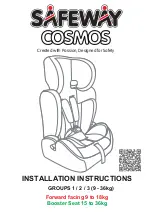
9
8
Location Warnings – continued
Rear-facing and Forward-facing Use
for a tight installation. If the child restraint cannot be
properly installed,
DO NOT
use the child restraint.
Consult vehicle owner’s manual, try a different seating
location, or call Evenflo for further assistance.
•
ONLY
use this child restraint on forward-facing
vehicle seats.
DO NOT
use this restraint with vehicle
seats that face the rear or side.
•
ONLY
use this child restraint on vehicle seats with
backs that lock into place.
Premature Infants
Rear-facing Use Only
•
DO NOT
use this or any child restraint with a
premature infant until after consulting your doctor.
Premature infants may have difficulty breathing when
in a seated or semi-reclined position. Using additional
padding or pillows behind the infant’s head or failing
to properly recline the child restraint could increase
the child’s risk of serious injury or death.
Rear-facing Only Warnings
• When using this restraint rear-facing,
DO NOT
loosen
the vehicle seat belt to provide more leg room, as this
will prevent the child restraint from protecting the
child.
• Fold-down armrests could pose a hazard to a
rear-facing child in certain types of collisions. Consult
your vehicle owner’s manual before installing any
rear-facing child restraint in front of a fold-down
armrest.
•
NEVER
turn a child restraint forward-facing with a
child who weighs less than 10 kg (22 lbs). Crash forces
may cause serious injury or death.
•
DO NOT
use the tether strap when the child restraint
is in the rear-facing position.
• The headrest on the vehicle seat that the child faces
when sitting in the rear-facing mode should be placed
in the lowest position. The vehicle seat back that the
child faces must be fully padded and free of any hard
objects.
Important
Forward-facing Only Warnings
• If your child weighs more than 29.4 kg (65 lbs) or
their shoulders are above the highest harness level,
you
MUST
discontinue using this child restraint as it
may no longer adequately protect your child.
•
MUST
be at least 2 years old.
• Adjust, or remove, the vehicle headrest in the
seat where the child restraint is to be installed,
so that the back of the child restraint rests against the
vehicle seat back.
• The headrest on the vehicle seat in front of the child
should be put in its lowest position. The vehicle seat
back that the child faces must be fully padded and
free of any hard objects.
Seat Belt Warnings
Rear-facing and Forward-facing Use
•
DO NOT
use this child restraint if it moves more than
25 mm (1 in.) side to side or front to back at either
the rear-facing or forward-facing belt path on the
child restraint. Serious injury or death may result from
poor installation. If you cannot tightly secure the child
restraint, try again or move it to another location.
•
DO NOT
use this child restraint in a seating position with
door-mounted seat belts.
•
DO NOT
use this child restraint in a vehicle with seat
belts that automatically move along the vehicle frame
when the door is opened. These seat belts will not hold a
child restraint properly.
•
DO NOT
use this child restraint in a vehicle equipped
with lap belts that only lock during a sudden stop or crash
(emergency locking retractor – ELR). You must use a seating
location with a locking seat belt. Check your vehicle owner’s
manual to see if you have lap belts with ELRs.
• If the vehicle seat belts are not routed and fastened correctly,
the child restraint may not protect the child in a crash.
•
DO NOT
allow the vehicle seat belt release button to
touch the child restraint. Accidental contact may cause
the seat belt to release. If necessary, turn the seat belt
release button away from the child restraint or move the
child restraint to a different location.
• Failure to adjust the harness or vehicle seat belts snugly
around the child may result in the child striking the
vehicle’s interior during a sudden stop or crash. Serious
injury or death may occur.
WARNING
WARNING






































